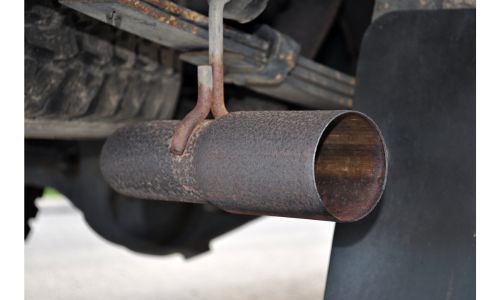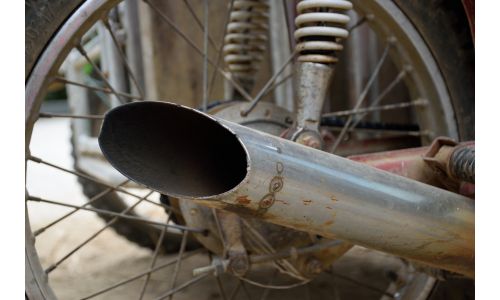Dealing with the engine sound, high temperature, and gas chemicals are the primary tasks of an exhaust pipe. Thus, exhaust pipe materials must be sturdy and durable enough to withstand the damages caused by these functions.
Manufacturers use aluminized steel, stainless steel, titanium, Inconel, nickel alloy, and cast iron materials for exhaust pipes. These materials are top picks due to their affordability, formability, and resistance against high temperature, road elements, and corrosion.
There are a few other materials that are often picked for several purposes. Read along to explore more details about the type of materials used for exhaust pipes with their key properties and usability.
What Types of Metals Are Used in Exhaust Pipe? In-Depth Discussion
Automakers have several metal options to choose from when manufacturing exhaust pipes. The type used depends on factors like cost, heat tolerance, desired lifespan, and ease of manufacture.
The materials used in manufacturing exhaust pipes are as follows.

1. Aluminized Steel
Aluminized steel is an alloy manufactured of carbon steel coated with a thin layer of metallic aluminum. The metallic layer is either sprayed or rolled onto the surface. This aluminum coating process reacts with oxygen to form a protective oxide film layer, which is a few nanometers thick. It provides an excellent protective layer against corrosion and heat.
We know that exhaust systems handle a high temperature of around a thousand degrees F. Thus, coated aluminized steel can offer great protection and maintain integrity better than other materials.
On the other hand, the oxide skin (corrosion of steel and iron) over the metal protects the base steel from erosion and oxidation. However, aluminized steel can be heavier compared to other materials.
Still, many automakers prefer aluminized steel for exhaust due to its affordability and rust-proofing qualities. Popular models like the Toyota Camry, Honda Accord, Ford F150, RAM 1500, etc., have aluminized steel exhaust pipes. These exhaust pipes usually cost between $20 to $100, depending on their sizes.
2. Stainless Steel
This is another material that can withstand heat over a thousand degrees F. Stainless steel allows a stainless steel exhaust pipe to retain shape and integrity without deterioration. Automakers often choose this material to ensure reliability and durability at an affordable price.
However, varieties of stainless steel are used as exhaust pipe materials. Such as —
- 400 Series Stainless Steel
This variety of stainless steel is a top choice for producing exhaust pipes. The 400 Series Stainless Steel contains 11% or 12% chromium. This substance creates a protective layer of oxide that defends against heat and corrosion.
Therefore, the 400 Series Stainless Steel can maintain structural integrity and handle high temperatures up to 900°F. As it has self-healing oxidation protection, automakers or the owner of the manufactured exhaust pipe doesn’t need to apply any additional coat. Besides, this stainless steel variation contains molybdenum, which boosts the material’s hardness, strength, and wear resistance. Hence, 400 stainless steel is favorable in terms of durability.
Moreover, this material, with outstanding heat and corrosion resistance, is cost-effective for high-end automotive manufacturing. The 400 Stainless Steel is also a popular pick for building engine parts. Vehicles like the Honda Civic, Mazda 3, Toyota Corolla, Ford Focus, and so on come with 400 Series Stainless Steel exhaust pipes. Depending on the size and thickness of these exhaust pipes, they range between $100 to $300.
- 400 Series Aluminized Stainless Steel
This material contains all the characteristics of 400 Series Stainless Steel. But the 400 Series Aluminized Stainless Steel has some unique features, making it more corrosion resistant than the 400 Stainless Steel exhaust pipe.
It contains a high aluminum level, between 90 to 93%, 11 to 13% chromium, and 7 to 9% silicon. The 400 Aluminized Stainless Steel also contains a small amount of carbon, manganese, phosphorus, niobium, and sulfur.
The formulation of these substances allows the material to react with oxygen and develop a thin layer of aluminum oxide. This thin layer boosts the protection against heat and erosion. Heavy-duty trucks, fleet vehicles, and off-road vehicles usually include exhaust pipes made of this material. Moreover, these exhaust pipes cost between $75 to $225.
- 409 Stainless Steel
This is one of the most commonly used exhaust pipe materials due to its outstanding combination of substances. Just like the other properties, the 409 Ferritic Stainless Steel can create oxide film protection using around 10.50 to 12.50% chromium. It protects against the chemicals and gasses in the exhaust system.
Additional elements such as nickel and silicon promote outstanding oxidation resistance and increase workability. Therefore, high heat resistance of up to 1500°F is one of the standout features of this material.
The 409 Stainless Steel also offers excellent formability, which allows the material to bend without cracking. Additionally, it contains a low thermal expansion substance, which creates a precise design to prevent gas leakage. You can find an exhaust pipe made of this material in Nissan 350Z, Audi S4, BMW M3, Honda Civic Si, etc. However, these exhaust pipes are cheaper than 400 Aluminized Steels, as these range between $30 to $100.
- 439 Stainless Steel
This stainless steel type is mostly used in luxury cars like SUVs, sports cars, and other branded cars with high-end performance. The 439 Stainless Steel is mostly known for its exceptional heat-resistant feature. It can maintain a good level of strength and integrity at high temperatures (up to 2400°F), thanks to the 18% chromium used in it. This substance also makes the material resistant to oxidation and corrosion.
Hence, the 439 stainless steel won’t degrade by high heat, chemicals, rock salt, and water. Plus, manufacturing an exhaust pipe with this material is relatively simple compared to other materials. This material also offers an extended service life, which is convenient for the owner.
So, which vehicles come with an exhaust pipe made of this material? Construction equipment, fleet, and off-road vehicles mostly include exhaust pipes made of this material. The price range for 439 Stainless Steel exhaust pipes is between $80 and $240.
- 300 Series Stainless Steel
Due to its formability, the 300 Series Stainless Steel is widely used as header, muffler, pipe, and exhaust manifold material. It contains between 16 to 30% of chromium and 6 to 20% of nickel.
Combining both properties makes this manufacturing material highly protective against corrosion, heat, road elements, and exhaust gasses. The 300 Series Stainless Steel can withstand up to 1500°F. The chromium substance forms a protective layer that helps the material prevent deterioration.
However, this material is prone to discoloration at high heat. You may find 300 Stainless Steel in commercial and semi-premium exhaust pipes.
300 Stainless Steel exhaust pipes are pretty expensive, ranging between $150 to $450. Both luxury and performance cars come with these exhaust pipes, such as the Porsche 911, BMW 7 Series, Audi A8, Ford Mustang, Toyota Tundra, Ford Raptor, etc.
- 304 Stainless Steel
This is another popular stainless steel grade from the 300 Series. The 304 Stainless Steel is also familiar with 18/8 Steel. It contains a similar composition to 300 Stainless Steel. Popular car models like Lexus LS, Mercedes-Benz S-Class, Jeep Wrangler, GMC Sierra, Nissan GT-R, and other brands use 304 Stainless Steel exhaust pipes.
The 304 Stainless Steel includes 18% chromium and 8% nickel, which balances flexibility, strength, and corrosion protection. Many automakers use this material for manufacturing exhaust pipes due to its affordability.
The 304 Stainless Steel is less expensive than any other stainless steel type. However, this exhaust pipe material can withstand 1500°F. Once the heat exceeds 1800°F, the 304 Stainless Steel can lose strength and color.
And exhaust pipes made of 304 Stainless Steel are cheaper than 300 Stainless Steel, ranging between $50 to $300.
3. Galvanized Steel
This material is formed with a carbon steel coating and a protective zinc layer. The prepared steel is dipped into the molten zinc. This process is known as hot-dip galvanizing to layer the steel with zinc. It forms a metallically bonded zinc coating that prevents the iron from damaging and deteriorating. However, as this material is uncoated, the galvanized steel has a heat resistance of a maximum of 600°F.
Therefore, galvanized steel is barely picked by automakers since the exhaust gas can go up to 1200°F. Thus, this metal can corrode easily at high temperatures.
Moreover, vehicle owners often use galvanized steel exhaust pipes as an affordable replacement, as these range between $30 to $90. However, some vehicles like the Toyota Corolla, Nissan Sentra, Ford Fusion, Toyota Avalon, and Chevrolet Silverado come with these exhaust pipes.
4. Low Carbon Cold Rolled Steel (CRS)
This material is similar to galvanized steel. Low-carbon cold rolled steel is not an ideal pick for manufacturing exhaust pipes. It contains a very low percentage of carbon (0.05 to 0.025%), which makes it perfect for welding quite easily. But as it’s uncoated steel, it can withstand 600°F temperature. Moreover, this material loses strength faster and can get eroded easily when exposed to moisture and chemicals.
Therefore, Low Carbon Cold Rolled Steel is only used when the purpose is to make exhaust system parts at a low price. You may find this material available for low-cost replacement or available in vehicles with basic systems. You can find an exhaust pipe made of CRS between $15 to $45, based on the size, thickness, and brand of the pipe. Usually, automakers of vehicles don’t pick this material for their exhaust pipes.
5. Titanium
This material is considered the popular exhaust system material due to its lightweight feature and outstanding strength. Even though this material is lightweight, it is two times sturdier than stainless steel.
Thus, manufacturers use this material to make the exhaust pipe lightweight without compromising durability. Besides, this material can maintain strength and integrity over 1600°F without losing its structure.
Additionally, the non-corrosive nature of titanium prevents the material from thinning. However, the drawback of this outstanding exhaust system material is the high price.
Unlike any other exhaust pipe materials, titanium is an expensive material mostly used with high-end vehicle brands for elite people. Plus, forming this material into an exhaust pipe needs skilled hands, which also increases the cost of the titanium exhaust pipe.
Titanium exhaust pipes can cost as high as $2,000 and as low as $500, which is still expensive compared to other materials above. Popular vehicles like the BMW M3, Lamborghini Huracan, Ferrari 488 GTB, Audi R8, etc., come with these premium exhaust pipes.
6. Inconel
This material is one of the best exhaust pipe materials, which offers high protection against heat and corrosion. Inconel contains a high percentage of nickel, around 50 to 55%.
It also includes 16 to 22% chromium, along with other small amounts of alloy components. This nickel-chromium superalloy material can withstand temperatures up to 1500°F. Not only that, Inconel can keep up its solid structure without cracking, discoloring, or scaling under extreme thermal cycles. This ability of Inconel makes it a better pick compared to traditional metal.
In addition, this material provides great oxidation resistance, which boosts the durability of Inconel. However, Inconel is an expensive material to manufacture exhaust pipes like titanium.
But this material is more expensive than titanium and other materials. Inconel exhaust pipes range between $1,000 to $5,000, and that’s why it’s mostly included in luxurious models. Vehicles like Formula One cars, race cars, supercars, and other high-end car models have these exhaust pipes.
7. Mild Steel:
This material is made of carbon and iron. Thus, it is also known as carbon steel. It has around 97 to 99% iron and a small amount of carbon between 0.05 and 0.25%. Mild Steel is economical for manufacturing exhaust system elements for basic passenger automobiles. The reason behind this is although this material is lightweight and sturdy, it gets rusted easily through air humidity.
Thus, mild steel exhaust pipes either come with a painted coating or the buyer needs to give it a paint coat to prevent rust. Hence, this affordable exhaust pipe is primarily available in warm and dry countries. The price range of exhaust pipes made of this material is similar to galvanized steel, between $30 and $90. Economy cars and mid-size cars mostly use mild steel exhaust pipes.
8. Nickel Alloys:
This material is formed with the combination of nickel and aluminum along with chromium. The chromium substance makes the material corrosion and heat-resistant. Due to its increased strength and resistance, nickel alloy is mostly used for manufacturing parts that deal with high temperatures, such as the exhaust system.
Plus, this material is lightweight, like titanium, but sturdier than titanium. However, exhaust materials that are lightweight and offer good protection at the same tend to be expensive, like titanium and Inconel.
It can withstand temperatures up to 1500° F. Due to the high stiffness and strength of this material, the process of welding, formation, and labor costs become expensive. But still comes under the budget of most people as these range between $100 to $500. Moreover, Formula One and race cars usually use this material for exhaust pipes.
9. Cast Iron
It has been used for manufacturing exhaust system parts and headers for a long time. Heat resistance, affordability, and vibration damping are the primary reasons behind its popularity. This material contains ductile iron substances with 2 to 4% carbon, which offers a great strength balance at high temperatures. Cast iron can withstand up to 900°F heat of the exhaust gas.
It also contains a small amount of silicon that increases the heat conductivity of cast iron. The vibration-damping quality of this material is an additional benefit to prevent engine buzz and enjoy a smooth ride.
You can find cast iron exhaust pipes between $80 to $230. Usually, popular brands don’t include cast iron exhaust pipes. But you can find these pipes on classic cars, buses, jeeps, Land Rovers, Mercedes-Benz, and affordable models of BMW.
However, this material can attract corrosion, which is slower than uncoated stainless steel. But it offers an amazing value proposition and production efficiency.
Comparison Chart of the Exhaust Pipe Materials
Here’s a comparison table between the mentioned exhaust pipe materials:
|
Materials |
Approximate Chemical Compounds | Usability | Lifespan (Minimum) |
| Aluminized Steel |
|
Exhaust systems, mufflers, valve covers, oil pans, radiators, heat shields |
5-10 years |
|
400 Series Stainless steel |
|
Exhaust systems, mufflers, valve covers, turbocharges, heat shields, suspensions | 10 years |
| 400 Series Aluminized Stainless steel |
|
Exhaust systems, mufflers, valve covers, driveshafts, turbocharges, heat shields, suspensions |
10 years |
|
409 Stainless Steel |
|
Exhaust pipes, heat shields, and mufflers |
10-13 years |
|
439 Stainless Steel |
|
Exhaust pipes, exhaust manifolds, valve covers, mufflers, heat shields |
10-15 years |
|
300 Series Stainless Steel |
|
Exhaust pipes, exhaust manifolds, mufflers, and heat shields |
20 years |
|
304 Stainless Steel |
|
Exhaust systems, fuel tanks, brake rotors and calipers, and suspensions |
15-20 years |
|
Galvanized Steel |
|
Exhaust systems, underbody panels, bumpers, wheel arches, and suspensions |
5-8 years |
|
Low Carbon Cold Rolled Steel |
|
Exhaust pipes, body panels, suspensions, and wheel arches |
5-10 years |
|
Titanium |
|
Exhaust systems, pistons, wheels, suspensions, and body panels |
10 years |
|
Inconel |
|
Exhaust systems, turbocharges, exhaust valves, rotors, superchargers, and heat exchangers |
10-15 years |
|
Mild Steel |
|
Exhaust pipes, body panels, chassis, and suspensions |
8-12 years |
|
Nickel Alloy |
|
Exhaust systems, engine components, turbocharges, fuel cells, catalytic converters, heat exchangers, and superchargers |
10-15 years |
|
Cast Iron |
|
Exhaust pipes, wheels, brake rotors, engine blocks, cylinder heads |
20-30 years |
How Will Exhaust Material Impact Sound?
The exhaust system includes mufflers and pipes. The muffler controls the sound loudness, and the pipes collect the noise from the engine. Thus, the sound coming from the exhaust system is affected by the shape and material of the exhaust pipe.
Thicker material reduces noise, and thinner material allows sound to pass through the pipe without dampening the sound too much. It means different metal combinations change the tone and volume of the exhaust pipe.
Here are some examples:
- Heavy exhaust pipe materials like iron and stainless steel absorb the engine noise.
- Lighter materials of exhaust pipe like Titanium, Inconel, and aluminum reflect the sound waves.
- Coated metals change the tone and volume of the engine sound over time. It may get louder with the deterioration of the exhaust pipe.
Which Exhaust Material is Right for You?
Your budget and required integrity and strength are the two main factors determining the type of exhaust pipe material you should choose. For example:
- If you’re too tight on your budget, aluminized steel can be a good option that offers 5 years of lifespan with decent corrosion resistance.
- Stainless steel can be your ideal choice if you have enough budget. These materials provide excellent resistance against heat and rust. Moreover, steel types offer high-end performance with a minimum lifespan of 10 years.
- In case budget isn’t a hindrance, consider picking premium materials like Titanium and Inconel. These materials are made of quality chemical compounds that make them sturdy and lightweight.

Conclusion
So, now you know the types of exhaust pipe materials used for manufacturing and how they contribute to the tone and loudness of the engine sound.
Generally, the automakers pick the material depending on the vehicle type and required exhaust system performance.
Aluminized steel exhaust pipes are best known for their decent protection against heat and deterioration at a moderate price. Stainless steel is the primary pick for most vehicles as it offers an extended lifespan and better performance than aluminized steel.
High-end and luxury vehicle brands include lightweight and sturdy materials like Inconel and titanium exhaust pipe. Moreover, materials like galvanized steel, CRS, and mild steel are used to build exhaust pipes for cheap replacement.

